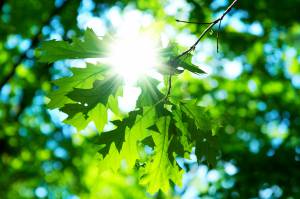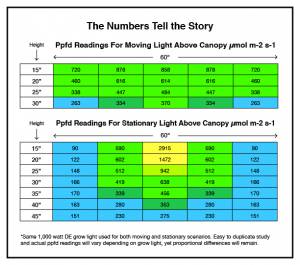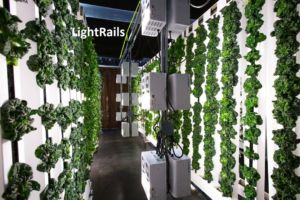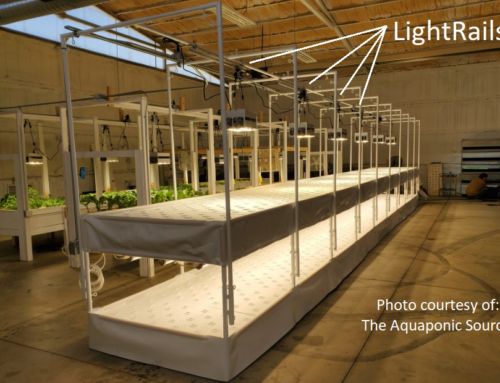
Leaf Area Index (LAI) is somewhat complicated as a formula, but it can be understood in simpler terms. Grow light Leaf Area Index is the measurement of the grow light affect this way. It’s a measurement of the total upper leaf surface exposed to direct indoor grow light. And, that is in relationship to the area of ground that the plant is taking up.
Full sun at the equator is 1990 Ppfd
As a related topic, indoor plant light is calculated in micro-moles shining on a square meter. To put this in perspective with nature compared to our grow equipment, we have this. Full sun at the equator is 1990 μmols-m2-s1. (1990 micro-moles per square meter per second). Or, another way to understand this is 1990 Ppfd as the very number for full, intense sunshine.
Indoor plant light saturation point for green leaf photosynthesis
A 1,000 watt indoor grow light should be able to reproduce a sunlight measurement of 1990 Ppfd, or higher. And, that’s at one foot from the grow lamp. Inverse Square Law, however, has grow light power reduced geometrically the farther away the grow lamp is placed. For example, at 19 inches the Ppfd is calculated this way: 1990÷(19″÷12″)2. And, that calculates to 794 μmols-m2-s1, which is 794 Ppfd, or a DLI of 34. That’s about the indoor plant light saturation point for green leaf photosynthesis.
The question then is to how to achieve an optimum grow light Leaf Area Index. And, that’s at the same time as we effectively cover the plant canopy with quality grow light interaction. So, our indoor plant light needs to be at the correct intensity. There are many grow light numbers to understand and to decipher and no matter the grow light; it should be maximized.
Up to 60% of our light energy is lost with stationary grow lights
 Depending on our indoor grow light configuration, we could be losing. And, that loss might be up to 60% of our light energy in the form of stationary grow light usage. That’s looking at the grow light effect and on how the plants can use it best. In other words, we want to maximize the grow light Leaf Area Index. And, that’s realized by getting the indoor plant light to be absorbed on the leaf surfaces at just the correct period of time, per surface.
Depending on our indoor grow light configuration, we could be losing. And, that loss might be up to 60% of our light energy in the form of stationary grow light usage. That’s looking at the grow light effect and on how the plants can use it best. In other words, we want to maximize the grow light Leaf Area Index. And, that’s realized by getting the indoor plant light to be absorbed on the leaf surfaces at just the correct period of time, per surface.
Ideal grow light Leaf Area Index is intermittent indoor grow light
What we know is indoor plant light can be optimized for a more ideal grow light Leaf Area Index . And, that same indoor plant light can be optimized to get the Ppfd to be stronger. So, we can get the Ppfd higher than would otherwise be tolerable. We can maximize both variables at once. The first thing to realize is ideal Leaf Area Index is intermittent indoor grow light interaction. So, how best to do this for the indoor grow room setup is to move our grow light system with LightRail light movers. That can be with LightRail 3.5 Kits, LightRail 4.0 Kits or LightRail 4.20 Kits. And, it’s the only way to get indoor grow lights close to the saturation mark of 794 Ppfd. That’s without the burn and the hot spot. This figure is for light loving plants with low light plants requiring less, of course.
Powerful but intermittent on the same leaves at about 40% of the photoperiod
We can address the grow light Leaf Area Index portion of the equation this way. With moving grow lights, we have powerful but intermittent grow light interaction. And, that’s on the same leaves at about 40% of the photoperiod. Plus, that’s with the correct intensity, so maximum grow light Leaf Area Index can be reached.
Leaf receptors open more with these intermittent conditions
Leaf area index really explains how plants have evolved over millions of years to most efficiently receive light. Outside, the sun comes at angles throughout the day. Or, it is intermittently blocked by close proximity leaves blowing in the breeze. Also, a constant, is intermittently diminished sunshine with the passing clouds. So, nature does it right. And, the leaf receptors open more when these intermittent conditions, producing optimum Leaf Area Index, are present.
Grow light movers duplicate what nature gets right

In artificial settings like an interior grow room setup, we have to strive for replicating what works so well in nature. In other words, we want to reproduce the actions of nature. And, we want to reproduce something close to natural sunshine. In contrast, stationary grow light setups beat straight down in a never changing way. So, we see the following result for the stationary grow light indoor grow room. The leaf receptors will actually shut down with this version of grow light overkill. Grow light movers, on the other hand, duplicate what nature gets right. So, it’s the single best way to deliver optimum Leaf Area Index to all the leaf surfaces at just the correct period of time.
Whether in a greenhouse or grow room, and whether for indoor farming or cannabis cultivation, LightRail light movers are the perfect solution. Better yields, fewer lights. LightRail light movers are rated the best grow light efficiency product on the market. Getting a more ideal plant light to more of the plants surfaces is a large part of that.





